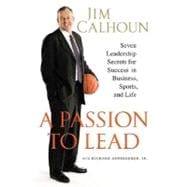
Note: Supplemental materials are not guaranteed with Rental or Used book purchases.
Purchase Benefits
What is included with this book?
JIM CALHOUN is the legendary coach of the University of Connecticut Huskies. He is among the winningest coaches in NCAA History. He is also one of only 5 active Division I coaches with at least 750 career wins. His Huskies captured the NCAA National Championship in 1999 and 2004. In 2005, Jim Calhoun was inducted into the Naismith Memorial Basketball Hall of Fame. He lives in Connecticut.
RICHARD ERNSBERGER, JR. is a veteran journalist who spent twenty years as a writer, correspondent, and senior editor with Newsweek magazine. He is the author of two successful books, Bragging Rights and God, Pepsi, and Groovin' on the High Side.
| Acknowledgments | p. v |
| Introduction: Above the Rim | p. 1 |
| Winning Every Day | p. 19 |
| Standards, Then Victories | p. 61 |
| Mind Games, or How to Be a Total Motivator | p. 101 |
| Flexible Thinking and the Power of Plan B | p. 141 |
| Tough in the Clutch | p. 195 |
| Mountaintop Management | p. 227 |
| The Woman in Section 114 | p. 257 |
| Table of Contents provided by Ingram. All Rights Reserved. |
The New copy of this book will include any supplemental materials advertised. Please check the title of the book to determine if it should include any access cards, study guides, lab manuals, CDs, etc.
The Used, Rental and eBook copies of this book are not guaranteed to include any supplemental materials. Typically, only the book itself is included. This is true even if the title states it includes any access cards, study guides, lab manuals, CDs, etc.
Excerpted from Passion to Lead: Seven Leadership Secrets for Success in Business, Sports, and Life by Jim Calhoun, Richard, Richard Ernsberger, Jr.
All rights reserved by the original copyright owners. Excerpts are provided for display purposes only and may not be reproduced, reprinted or distributed without the written permission of the publisher.